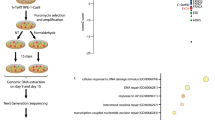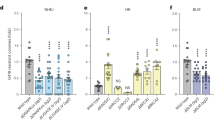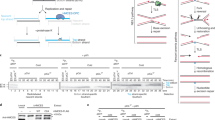Abstract
Metabolism is predicted to generate formaldehyde, a toxic, simple, reactive aldehyde that can damage DNA. Here we report a synthetic lethal interaction in avian cells between ADH5, encoding the main formaldehyde-detoxifying enzyme, and the Fanconi anemia (FA) DNA-repair pathway. These results define a fundamental role for the combined action of formaldehyde catabolism and DNA cross-link repair in vertebrate cell survival.
This is a preview of subscription content, access via your institution
Access options
Subscribe to this journal
Receive 12 print issues and online access
$189.00 per year
only $15.75 per issue
Buy this article
- Purchase on Springer Link
- Instant access to full article PDF
Prices may be subject to local taxes which are calculated during checkout



Similar content being viewed by others
References
Muller, L.U. & Williams, D.A. Mutat. Res. 668, 141–149 (2009).
Crossan, G.P. et al. Nat. Genet. 43, 147–152 (2011).
Stoepker, C. et al. Nat. Genet. 43, 138–141 (2011).
Kim, Y. et al. Nat. Genet. 43, 142–146 (2011).
Joenje, H. & Patel, K.J. Nat. Rev. Genet. 2, 446–457 (2001).
Patel, K.J. & Joenje, H. DNA Repair (Amst.) 6, 885–890 (2007).
de Winter, J.P. & Joenje, H. Mutat. Res. 668, 11–19 (2009).
Rosado, I.V., Niedzwiedz, W., Alpi, A.F. & Patel, K.J. Nucleic Acids Res. 37, 4360–4370 (2009).
Langevin, F., Crossan, G.P., Rosado, I.V., Arends, M.J. & Patel, K.J. Nature 475, 53–58 (2011).
Mosammaparast, N. & Shi, Y. Annu. Rev. Biochem. 79, 155–179 (2010).
Ridpath, J.R. et al. Cancer Res. 67, 11117–11122 (2007).
Noda, T. et al. Biochem. Biophys. Res. Commun. 404, 206–210 (2011).
Nomura, Y., Adachi, N. & Koyama, H. Genes Cells 12, 1111–1122 (2007).
Trewick, S.C., Henshaw, T.F., Hausinger, R.P., Lindahl, T. & Sedgwick, B. Nature 419, 174–178 (2002).
Falnes, P.O., Johansen, R.F. & Seeberg, E. Nature 419, 178–182 (2002).
Iborra, F.J. et al. J. Histochem. Cytochem. 40, 1865–1878 (1992).
Mosedale, G. et al. Nat. Struct. Mol. Biol. 12, 763–771 (2005).
Zhang, X.Y. et al. PLoS Genet. 5, e1000645 (2009).
Acknowledgements
We thank N. Adachi and H. Koyama (Kihara Institute for Biological Research, Japan) for kindly providing NALM-6 human cell lines. We are grateful to J. Sutherland and K. Lang (MRC Laboratory of Molecular Biology) for chemical insight and to M. Daly and F. Zhang (MRC Laboratory of Molecular Biology) for invaluable help with flow cytometry. I.V.R. and F.L. are funded by the Fanconi Anaemia Research Fund and Children's Leukaemia Trust, respectively.
Author information
Authors and Affiliations
Contributions
I.V.R. and K.J.P. designed the study and the experiments, and wrote the paper. I.V.R. performed the majority of the experiments presented. F.L. contributed to DT40 clonogenic assays and assisted in the generation of ADH5-deficient cell lines. G.P.C. helped with analysis of chromosome breaks. M.T. generated and provided the FANCD2 inducible cell line.
Corresponding author
Ethics declarations
Competing interests
The authors declare no competing financial interests.
Supplementary information
Supplementary Text and Figures
Supplementary Methods and Supplementary Figures 1–5 (PDF 3850 kb)
Rights and permissions
About this article
Cite this article
Rosado, I., Langevin, F., Crossan, G. et al. Formaldehyde catabolism is essential in cells deficient for the Fanconi anemia DNA-repair pathway. Nat Struct Mol Biol 18, 1432–1434 (2011). https://doi.org/10.1038/nsmb.2173
Received:
Accepted:
Published:
Issue Date:
DOI: https://doi.org/10.1038/nsmb.2173
This article is cited by
-
Adenine base editing efficiently restores the function of Fanconi anemia hematopoietic stem and progenitor cells
Nature Communications (2022)
-
Endogenous formaldehyde scavenges cellular glutathione resulting in redox disruption and cytotoxicity
Nature Communications (2022)
-
The structure-specific endonuclease complex SLX4–XPF regulates Tus–Ter-induced homologous recombination
Nature Structural & Molecular Biology (2022)
-
FANCD2 maintains replication fork stability during misincorporation of the DNA demethylation products 5-hydroxymethyl-2’-deoxycytidine and 5-hydroxymethyl-2’-deoxyuridine
Cell Death & Disease (2022)
-
Fanconi anemia proteins participate in a break-induced-replication-like pathway to counter replication stress
Nature Structural & Molecular Biology (2021)



